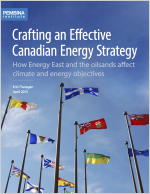Everyone is talking about climate change lately — at least at the provincial level. The past week has brought several significant developments across the country, all related to how provinces can cut carbon pollution.
Last Tuesday a group of prominent economists issued a report showing how every province can reap substantial economic benefits by putting a price on carbon. Yesterday Ontario committed to implementing a cap-and-trade system, meaning Canada’s most populous province will now put a price on carbon pollution. And today, Canada’s premiers are meeting in Quebec City to discuss climate change, energy and the environment.
When it comes to reducing carbon emissions, each province faces unique circumstances in terms of its industrial footprint, fuel consumption habits and electricity system. But while their challenges are distinct, every province is set to benefit from pricing carbon pollution and fighting climate change.
For example, Ontario will be using revenue from its cap-and-trade system to fund initiatives that improve our everyday lives, such as public transit infrastructure. That’s a sensible choice for a province where the transportation sector is the largest and fastest-growing source of carbon pollution.
When considering provincial initiatives, we must remember that ours is an increasingly interconnected world — and that trend applies equally to the provinces within Canada’s federation. Inaction or inadequate efforts in one province can counteract the progress made by others in reducing Canada’s carbon emissions.
Projects like the proposed Energy East pipeline put provincial interconnections into sharp focus. It would be the largest oil pipeline in North America, spanning 4,600 kilometres while passing through six provinces, 90 watersheds and more than 50 First Nations communities. The crude production needed to fill it would put up to 32 million tonnes of carbon pollution into our atmosphere each year.
Energy East is also an object lesson in why provinces are taking the lead on climate and energy issues: because the federal government is missing in action.
Canada lacks a plan to meet our 2020 climate change target — a commitment we share with the United States — and we’re on track to miss it by a wide margin. We still have no federal emissions regulations for the oil and gas sector, despite it being our largest and fastest-growing source of carbon pollution.
For pipelines such as Energy East, Canada also has a broken review process. The National Energy Board evaluates the economic benefits of producing crude oil to fill the pipeline as part of its review, yet it refuses to consider evidence about the environmental impacts of that same oil production — a double standard with no clear justification.
In the absence of federal leadership, individual provinces have taken unprecedented actions. In November, Quebec’s National Assembly passed a unanimous resolution expressing their lack of confidence in the federal review process for the pipeline, given that it turns a blind eye to upstream climate impacts. The Quebec and Ontario governments then outlined seven conditions that Energy East must meet before they will condone the project.
The premiers are also developing collaborative mechanisms to address these issues. In December, Ontario Premier Kathleen Wynne pledged to include Energy East’s climate impact in discussions of a multi-provincial Canadian Energy Strategy. That strategy, which will be unveiled in July, could provide premiers with an alternative to these ad hoc measures.
So what would a credible and effective Canadian Energy Strategy look like? Today the Pembina Institute released a report delving into that question.
 An effective strategy must address the largest and fastest-growing sources of carbon pollution in every province. Carbon pricing is part of that solution, but the strategy must also account for the climate footprint of new energy infrastructure.
An effective strategy must address the largest and fastest-growing sources of carbon pollution in every province. Carbon pricing is part of that solution, but the strategy must also account for the climate footprint of new energy infrastructure.
Energy East serves as an excellent test case. We know that the oilsands are the fastest-growing source of emissions in Canada. The additional emissions that would come from filling the Energy East pipeline with crude are roughly equal to the emissions reductions resulting from Ontario’s coal phase-out. No energy strategy can be credible without addressing that elephant in the room.
A successful Canadian Energy Strategy also needs to be far-sighted. As the world transitions toward a low-carbon future, Canada needs to capitalize on the growing clean technology market. The federal government created an intellectual deficit in this area when it disbanded the National Round Table on the Environment and the Economy. Our premiers could do a great deal of good by reviving the round table’s work.
In Canada, our energy and climate change strategies must go hand-in-hand — there’s no way around that reality. Canadians are fortunate to have premiers that are taking up the gauntlet themselves. We hope the energy strategy they develop meets the challenge.






